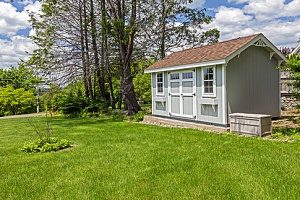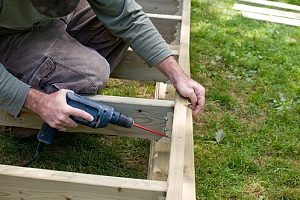 One of biggest challenges that can be overlooked when it comes to building a shed in your backyard, is where it is going to go. You need to consider if you want the shed to be close to your home if you want it out of the way so you have the most backyard space if the ground is flat, and if there are any tree or other objects that you will have to work around. Yard leveling is one of the most crucial components of building a shed in your backyard. It is also important to take into consideration if your backyard has any rainwater flooding problems. If you have noticed areas of your yard collecting water, this is probably not the best place to put your shed.
One of biggest challenges that can be overlooked when it comes to building a shed in your backyard, is where it is going to go. You need to consider if you want the shed to be close to your home if you want it out of the way so you have the most backyard space if the ground is flat, and if there are any tree or other objects that you will have to work around. Yard leveling is one of the most crucial components of building a shed in your backyard. It is also important to take into consideration if your backyard has any rainwater flooding problems. If you have noticed areas of your yard collecting water, this is probably not the best place to put your shed.
If you build your shed on top of land that is not flat, you are setting yourself up to have serious problems as you go further into the construction of your shed. You need level land to be able to build a sturdy foundation that is going to be able to support your shed and everything you store in it. The foundation is going to make sure that the shed is not in danger of moving or having a weak floor that could lead to damage in the future. Not only is building on a slope going to create an unsteady shed, but it is also going to make building the shed much harder. If you do not build on land that is completely flat, you are going to find things like your measurements not lining up, that one wall is higher than the others, or that your roof is slanted. It is possible to take the time to accommodate these problems, but then you are putting in a lot of extra work for a shed that you cannot even guarantee is stable.
Once you have decided where to place your shed, it is very unlikely that the ground is perfectly level. This means you are going to have to put some work into making sure your shed has a flat spot to sit on. Yard leveling is not a very complicated process and it should not take you too long. However, leveling the ground does not mean you can just look at it and say it looks flat. You actually need to measure it to ensure the area is entirely flat. If the area is not flat, you are going to need to use some fill dirt so you can create a flat base that is sturdy and stable enough to support your shed.
Land Grading
 Land grading is the process of making a level or slope base. In this case, you will create a flat surface for the foundation of your shed. To complete your lang grading project you are going to need to use fill dirt. Fill dirt is used for many construction purposes. In fact, it might even be what was used to help create the foundation of your house. Fill dirt can also be used for highway maintenance, filling inground pools, and land grading – so you know it is a reliable material. Fill dirt is vastly different from the dirt that is already in your backyard. This is because the dirt in your yard contains what is called organic matter. This organic matter is what helps support the growth of your grass, but is what also makes it unsuitable for yard leveling where you shed is going to go. Organic matter breaks down over time, and as it does the volume of the dirt changes, which can result in shifting of the dirt. Shifting dirt under your shed is the absolute last thing you want. Shifting dirt will cause you not to have a shed for very long.
Land grading is the process of making a level or slope base. In this case, you will create a flat surface for the foundation of your shed. To complete your lang grading project you are going to need to use fill dirt. Fill dirt is used for many construction purposes. In fact, it might even be what was used to help create the foundation of your house. Fill dirt can also be used for highway maintenance, filling inground pools, and land grading – so you know it is a reliable material. Fill dirt is vastly different from the dirt that is already in your backyard. This is because the dirt in your yard contains what is called organic matter. This organic matter is what helps support the growth of your grass, but is what also makes it unsuitable for yard leveling where you shed is going to go. Organic matter breaks down over time, and as it does the volume of the dirt changes, which can result in shifting of the dirt. Shifting dirt under your shed is the absolute last thing you want. Shifting dirt will cause you not to have a shed for very long.
Preparation
After you have decided on the location of where your shed is going to go, you need to clear the area. This includes removing any grass, trees, or foliage. Next, you want to mark out the parameters of where the shed is going to go using stakes. Once the stakes are in place, you need to decide what height you are going to consider “level.” Most of the time it is easier to build up the ground than it is to have to dig and worry about removing dirt, especially because you are going to have to add dirt anyway. Find a spot within the parameters of your shed that you are going to build up the rest of the area to match and mark it with a stake.
Yard Leveling
Once you have decided what height you want to build up to, you want to use your fill dirt so that all areas within the parameters of the shed reach that height. You will probably want to add a little extra fill dirt to make it slightly higher because once you compact the dirt you will find suddenly that the area is just a smidge too low to reach your level point.
Compress The Fill Dirt
 Next, you are going to take fill dirt and cover the entire area the shed is going to be resting on. It is very important that you remember to use fill dirt for this step and not any other type of dirt. For example, if you decide to use dirt from elsewhere in your yard, you have no way of ensuring that it does not contain organic matter. Fill dirt that has been screened and can be trusted to support the weight of your shed.
Next, you are going to take fill dirt and cover the entire area the shed is going to be resting on. It is very important that you remember to use fill dirt for this step and not any other type of dirt. For example, if you decide to use dirt from elsewhere in your yard, you have no way of ensuring that it does not contain organic matter. Fill dirt that has been screened and can be trusted to support the weight of your shed.
Applying a good inch or so of fill dirt over the area should do the job. Following placing down the fill dirt, you need to compact it. There is nothing fancy about this step, you can do it with your hands and feet if you want. Or you can get a flat wood board to lay down overtop the dirt and apply pressure. The board will help you to cover more area in less time.
Once you have completed this, you have created a sturdy, level area where you can proceed with building your shed. Yard leveling is going to make every part of building your shed easier, as well as ensure that nothing will be able to make your shed shift. Reach out to Dirt Connections for more information about yard leveling and to schedule your free fill dirt delivery.









































